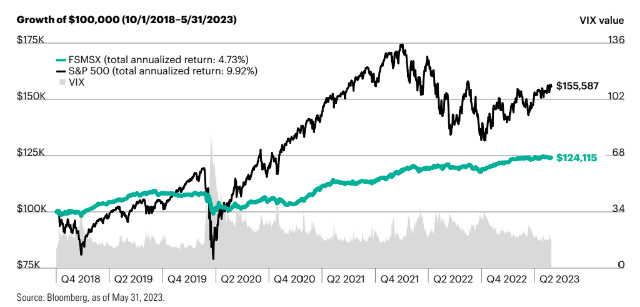The Cost of Volatility

When it comes to investing, humans hate volatility. Mostly because they define volatility as “the market going down.” However, volatility also occurs when markets go up and, as a general rule, anything an investor does to reduce volatility to the downside will also reduce volatility to the upside.
This is important because markets tend to go up more than they go down. By minimizing the short-term drawdowns, investors are also limiting their exposure to the more significant long-term uptrends.
We do a lot of research on this topic, and as far as we can tell, there is no way around it. No strategy, no matter how complex, can generate equity like returns with cash-like volatility.
So Why Do a Lot of Rich People Use Complex Strategies?
Mostly because complexity is often confused with sophistication. In Warren Buffett’s 2016 note to shareholders (pages 21 – 24 are must-reads), he describes his bet with hedge fund manager Ted Seides, where Buffett put his money on an S&P 500 index fund and the hedge fund manager put his money on a group of five hedge funds. From 2008 – 2016 the S&P was up an average of 7.1% whereas the hedge funds only delivered average annual returns of 2.2%.
So, yes, the hedge funds had less volatility (defined as dispersion around the average return) but that volatility came at a huge cost for long-term investors.
An Example of Unnecessary Complexity
I was recently looking at a couple’s portfolio and one of their holdings was the FS Multi-Strategy Alternatives Fund (Ticker FSMSX). Morningstar gives it their highest rating of five stars, meaning they believe it has better “risk-adjusted returns” than most of the other 125 funds in the Morningstar Multistrategy category and the fund manages nearly $1 billion in assets.The fund’s overview describes it as “a liquid alternative, multi-strategy solution that seeks to generate absolute, low-correlated returns over a complete market cycle to help lower portfolio volatility.”
The fund’s strategy has three bullet points:
Partnering FS Investments & Wilshire to build a balanced, macro-aware portfolio.
Using a broad toolkit of active hedge fund managers and alternative risk premium strategies.
Incorporating strategic and opportunistic allocation to target specific drivers of return and risk.
I don’t know what most of that means but the fund allocates to 6 different hedge funds in different proportions, as well as four different risk premia strategies (Equity, Macro, Technical Trading, & Volatility). The management cost for their efforts is 2.17% / year before any fee waivers. The fund’s volatility has been much lower than the S&P 500, however, the annualized return from the fund’s inception in May of 2017 to the end of March 2023 was 3.39%. During that same period, the S&P 500 had annualized returns of 11.56%.
This chart on the fund’s fact sheet goes from 10/1/2018 - 5/31/2023 (note the cherry picking of dates to get the fund’s returns up to an annualized 4.73% v. 9.92% for the S&P 500).
As a long-term investor, which line would you rather be on?
The Tax Issue
Even in Buffett’s bet with the hedge fund manager, the investments were treated as being completely tax-free. However, for many of the wealthiest people using complex strategies like the one I described here, that is not the case. These investments are held in taxable accounts, and this can make a big difference when calculating the after-tax rate of return (which is the only kind of return that matters).
Whereas the dividends on a bought and held position in an S&P 500 index fund are generally taxed at lower qualified dividend rates and the capital gains are easily deferred until the position can be taxed at long-term capital gain rates upon sale (or the position is never sold, the heirs get a stepped up basis and avoid capital gains entirely) that isn’t possible with highly active positions. For complex, actively managed funds, the dividends and capital gains (which are recognized inside the fund whether the investor sells or not) are generally going to be taxed at ordinary income rates.
We Continue to Believe There is Value in Simplicity
If you ever wonder why we aren’t trading more often, or leveraging more alternatives, it is because we don’t believe these things add value. However, we are always performing due diligence on different managers and investment options so if you ever want us to look at something you have seen or something you are being offered, please don’t hesitate to let us know. We’ll be happy to research and give you our thoughts.




When it comes to writing about investments, the disclaimers are important. Past performance is not indicative of future returns, my opinions are not necessarily those of TSA Wealth Management and this is not intended to be personalized legal, accounting, or tax advice etc.
For additional disclaimers associated with TSA Wealth Management please visit https://tsawm.com/disclosure or find TSA Wealth Management's Form CRS at https://adviserinfo.sec.gov/firm/summary/323123